Beef Soup Bones Recipes—What are they and how to cook them?
Beef soup bones are a highly underrated cut of beef. They are extremely nutritious, delicious, low cost, and one of our long time favorites. Let’s dive into exactly what beef soup bones are and how to cook them to maximize their taste and nutrition.
We’ll even share how we like to use beef soup bones in our favorite recipes.
Nose to Tail Cooking
Collagen powders. Premade stocks and broths. Culturally we’ve shifted toward these convenient foods.
But behind every convenience, something is lost. In this case, handing down the skills to cook cuts of beef, like beef soup bones, has been lost in favor of a steady diet of steaks, ground beef, and traditional roasts.
There could also be a nutritional loss, which we’ll look at more.
We certainly didn’t grow up eating nose to tail with liver, heart, or beef soup bones making a regular appearance on our dinner table as our Grandparents did.
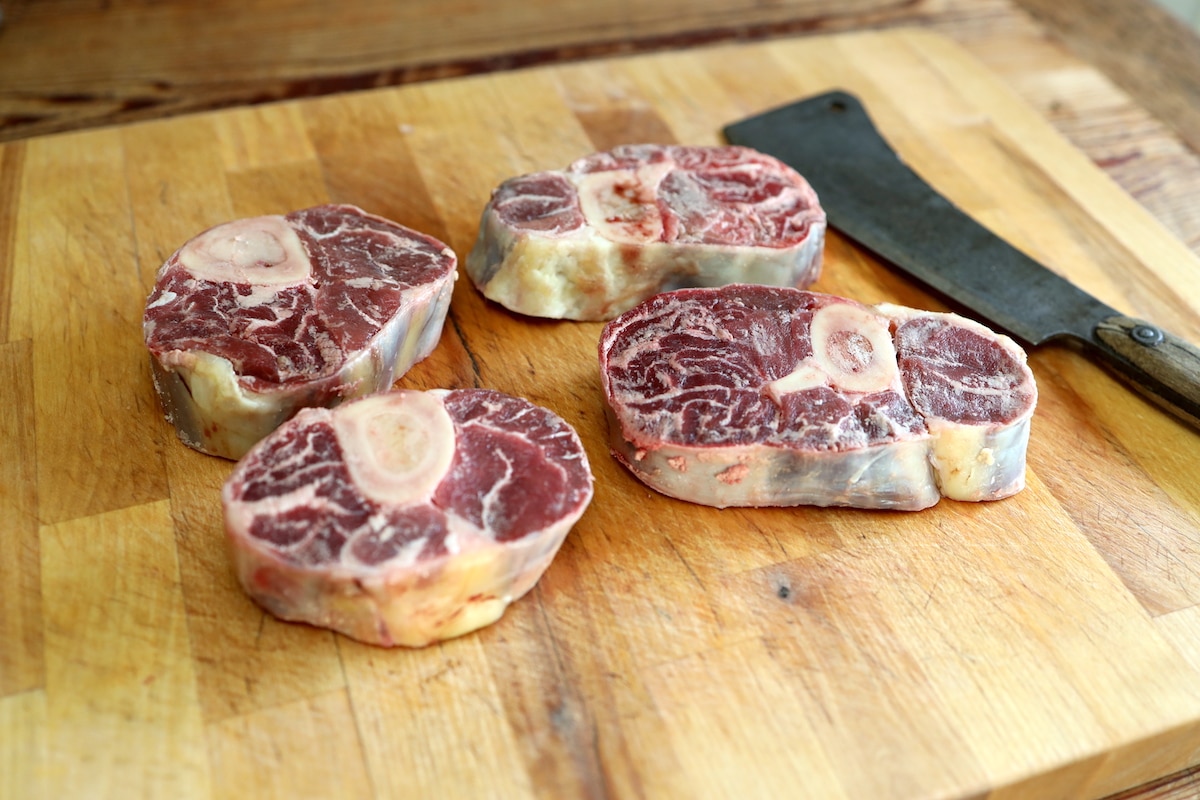
But, as we’ve challenged ourselves to include more organ meats and a nose to tail approach to our cooking and eating, we’ve been pleasantly surprised by both the health benefits and immense appreciation it has given us for the animals that we raise and the meat that we are eating.
What are Beef Soup Bones?
Beef soup bones are a cut of beef that comes from the shank marrow bone or the upper leg of the animal. They are a roughly 4–6-inch oval-shaped disc, approximately 1” deep, with a cylindrical marrow bone surrounded by meat all around.
They may be labeled at the butcher as a beef shank. But our butcher labels this cut of beef as beef soup bones. Beef soup bones or beef shanks are best known in the Italian dish osso buco or Vietnamese Pho.

How to Cook Beef Soup Bones
As you can imagine, the upper leg is a highly worked part of the cow. Because of this, beef soup bones are a tough and lean cut of beef.
They are best slow cooked or cooked low and slow through stewing or braising. When cooked this way, the result is a melt-in-your-mouth, fall-off-the-bone, piece of beef. As the name implies, beef soup bones also make a nutrient rich and delicious broth with high amounts of vitamins, minerals, collagen, and gelatin present. More on that next.
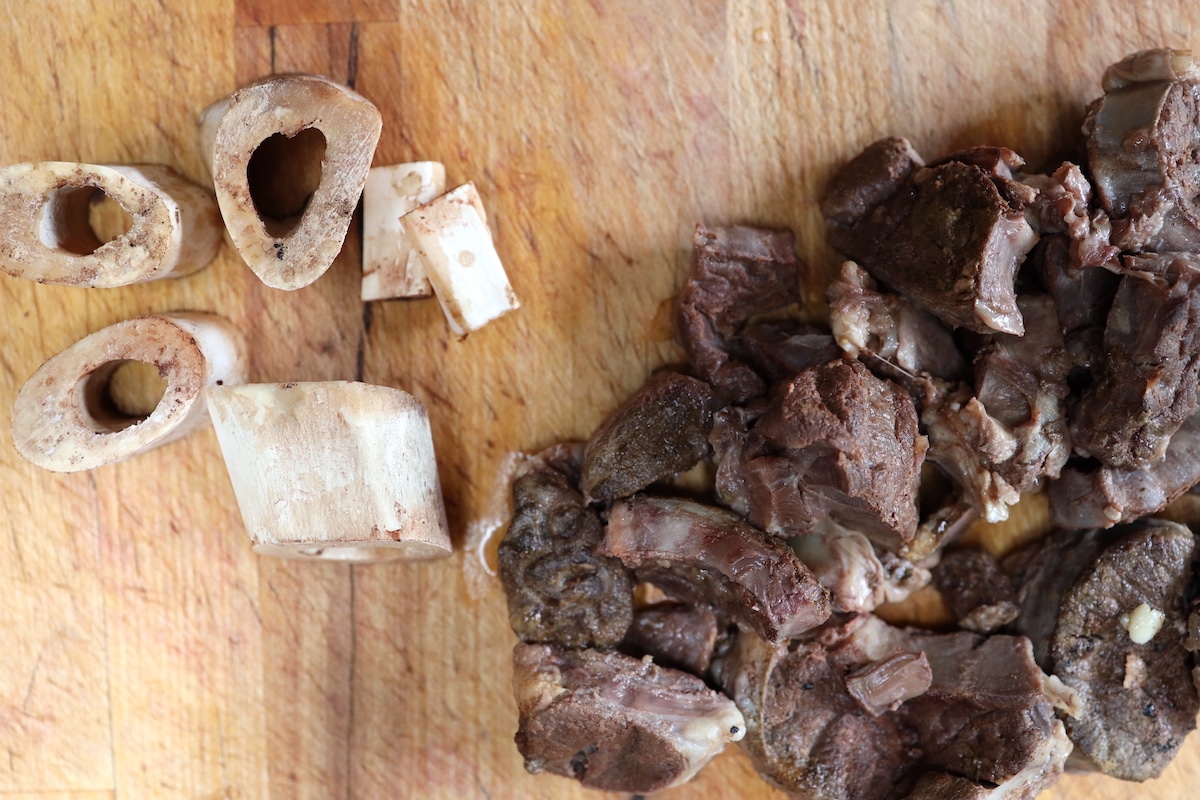
Nutritional Benefits of Beef Soup Bones
One of the unique benefits of beef soup bones is that they contain the marrow bone with the marrow inside. The bone marrow is essentially the fatty tissue found in the center of a bone. It tends to be most highly concentrated in the leg.
Bone marrow has long been prized for its abundant nutrition and healing properties. It is known to:
- Be highly beneficial for digestion and healing the digestive tract
- Boost the immune system
- Reduce inflammation
This is why bone broths have gained so much popularity for their health promoting properties in recent years!

Bone marrow is also a great source of vitamins and minerals, often even more so than meat. Vitamin E is significantly higher by as much as 4 times in the bone marrow than in meat while also containing twice as much vitamin A and B1.
As a personal antidote, I’ve always craved bone broth and bone marrow specifically when breastfeeding. Lo and behold, bone marrow contains alkylglycerols, which are immune boosting lipids that are a key ingredient in white blood cell production and are also found in breast milk. It always amazes me how clearly the body can show us what we need if we are paying attention.
Beef soup bones are also abundant in collagen, the structural protein in the body that is responsible for healthy skin, joints, and hair. This cut of beef is rich in connective tissue that turns into collagen when cooked down.
Beef Soup Bones – Frequently Asked Questions
How much do beef soup bones cost?
This is one big benefit to these more uncommon cuts of beef—they generally come at a fraction of the price of more premium cuts. Cost will vary widely based on location and farm. I’ve seen anywhere from $3/lb. and upwards of $8-10/lb.
How do beef soup bones differ from other beef bones?
The beef soup bones we are talking about here are sometimes called meaty soup bones or beef shank. If the package is just labeled “soup bones”, it may refer to just the bones from other parts of the animal and not contain the same marrow bone that beef soup bones contain.
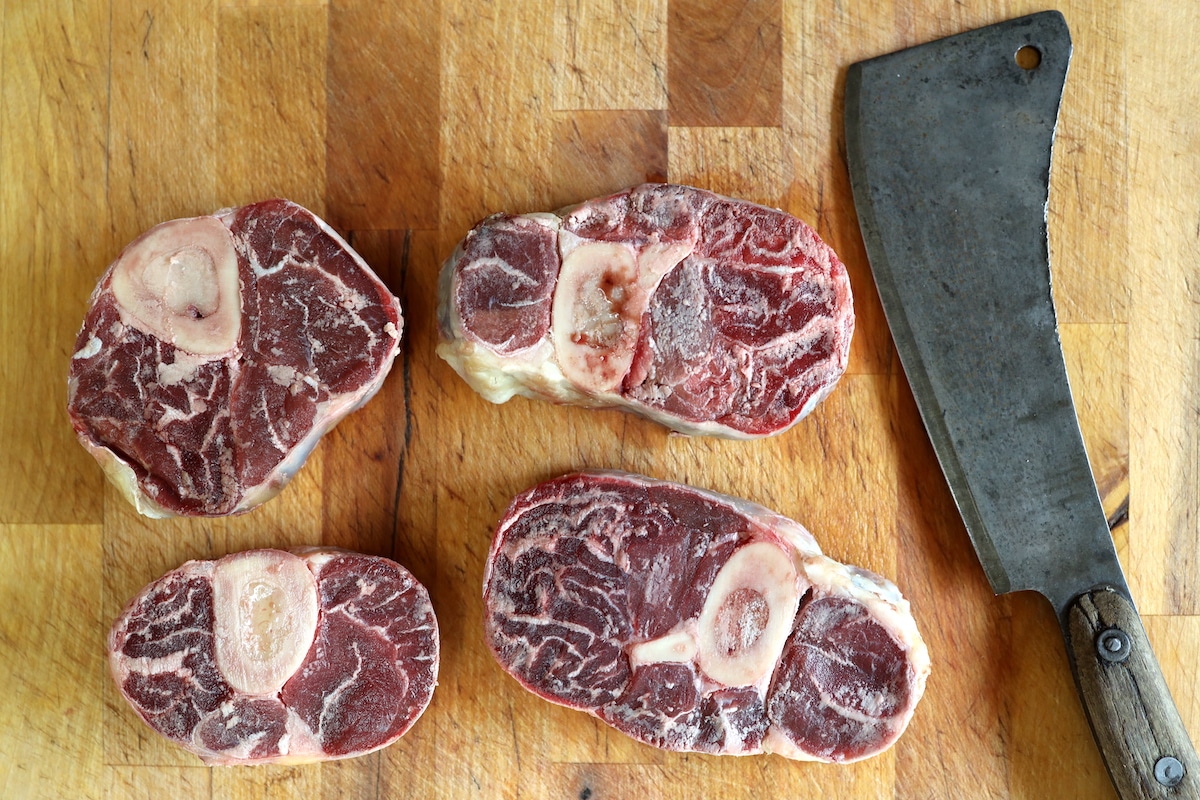
Can you freeze beef soup bones?
Yes! We keep beef soup bones in our freezer until ready to use. Then I pull them out to thaw in the fridge a day or two before using. After cooking, you can also refreeze just the marrow bone to use again for making broth if desired.
Where can I find beef soup bones?
You should be able to find beef soup bones or beef shank at your local grocery store or butcher. Or, you can often purchase them directly from a local farm. Check out localharvest.org to look for a farm near you!
What is the difference between grassfed vs. grain fed soup bones?
The difference is the diet that the cow has consumed. A grassfed diet consists of a diet solely on pasture grass and hay versus a cow fed grain primarily made up of corn. We prefer to feed our cows solely grass and rotationally graze them through our pasture to most closely mimic the diet they would have eaten prior to conventional farming practices.
How to Slow Cook Beef Soup Bones for Broth
In order to achieve the best taste, texture, and nutritional benefits from beef soup bones, our favorite way to cook them is in a slow cooker.
Before placing them in a Dutch oven to slow cook in the oven or a crock pot, we like to sear the soup bone on each side. While this doesn’t do anything for nutritional purposes, it does help bring out a depth of flavor in your beef and broth.
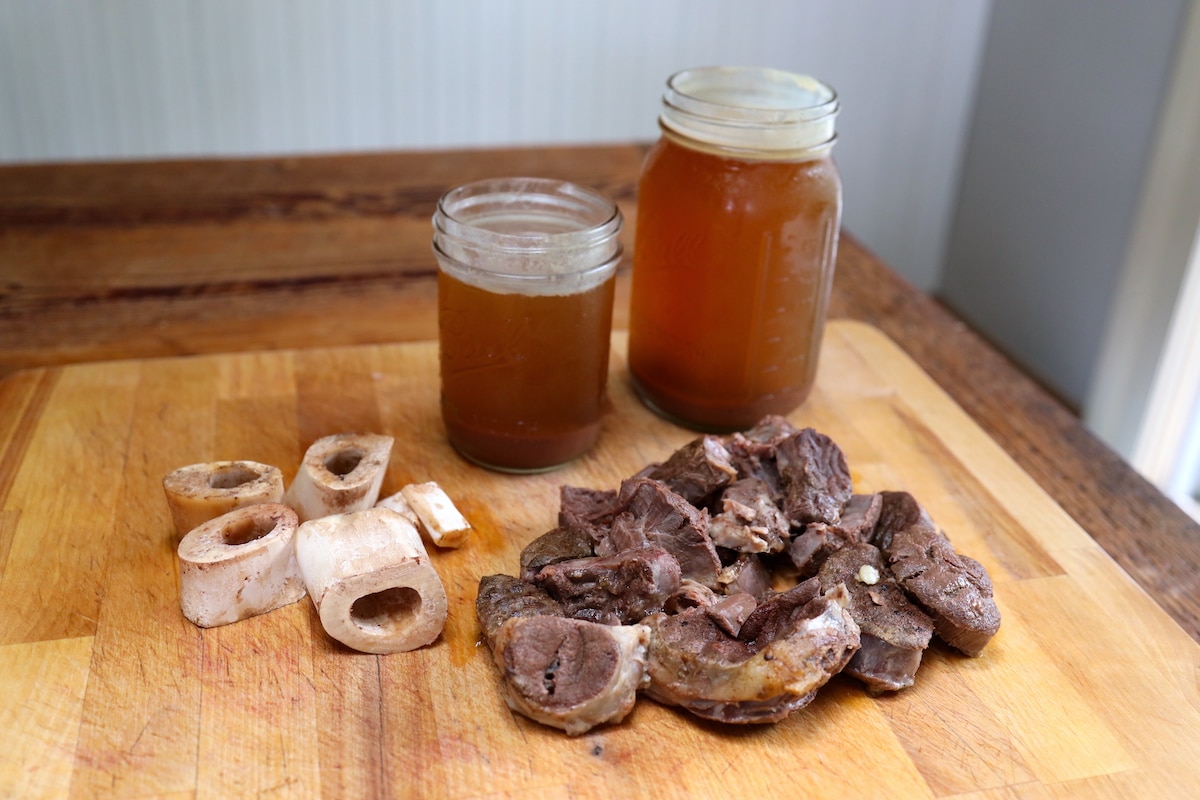
After the beef soup bones are seared, place them in a Dutch oven or crock pot and cover them with water.
Slow cook on low for 8 hours in a crock pot or place Dutch oven in a 200°F oven for several hours.
Alternatively, you can make broth from your beef soup bones by simmering on the stove for 2-3 hours.
From there, strain broth from the remaining meat and bone for a deliciously flavorful and gelatin filled broth.
The strained-out meat is perfect for adding into soups or stews with the delicious broth you just made! It will be extremely tender, melt in your mouth meat at this point. Some say that it loses its flavor after being cooked so long in the broth making process, but we haven’t experienced this!
One Pot Beef Soup Bone Vegetable Stew
Another way to cook beef soup bones is to make a nourishing, one pot beef soup bone vegetable stew. This recipe is an adaptation of the recipe for the beef soup bone broth above but with herbs and vegetables added to it to make a one pot meal.
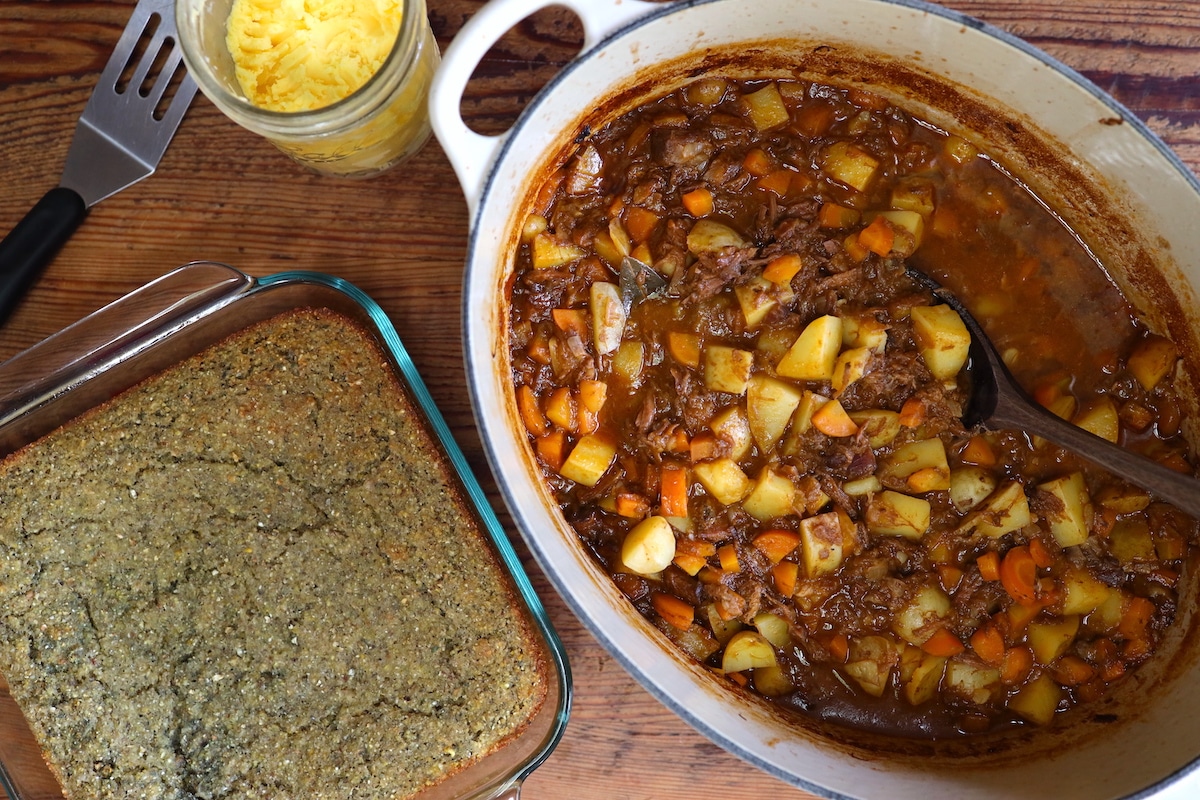
This is one of those highly adaptable recipes based on your tastes and preferences. But this is our favorite recipe for beef vegetable stew from beef soup bones.
Beef Soup Bone Vegetable Stew Recipe
Ingredients:
– 2-3 lbs beef soup bones
– 1 tbsp apple cider vinegar
– 6 cups water
– 2 tbsp olive oil or other cooking fat
– 4 cloves garlic, minced
– 1 onion, diced
– 1.5 lbs potatoes, chopped
– 4 carrots, diced
– 1 cup tomato sauce
– 2 tbsp Worcestershire sauce
– 1 tsp fish sauce (optional)
– 2 bay leaves
– 1 tbsp salt
– 1 tsp pepper
– 3 tbsp tapioca or arrowroot starch (or other thickener) dissolved in 2-3 tbsp water
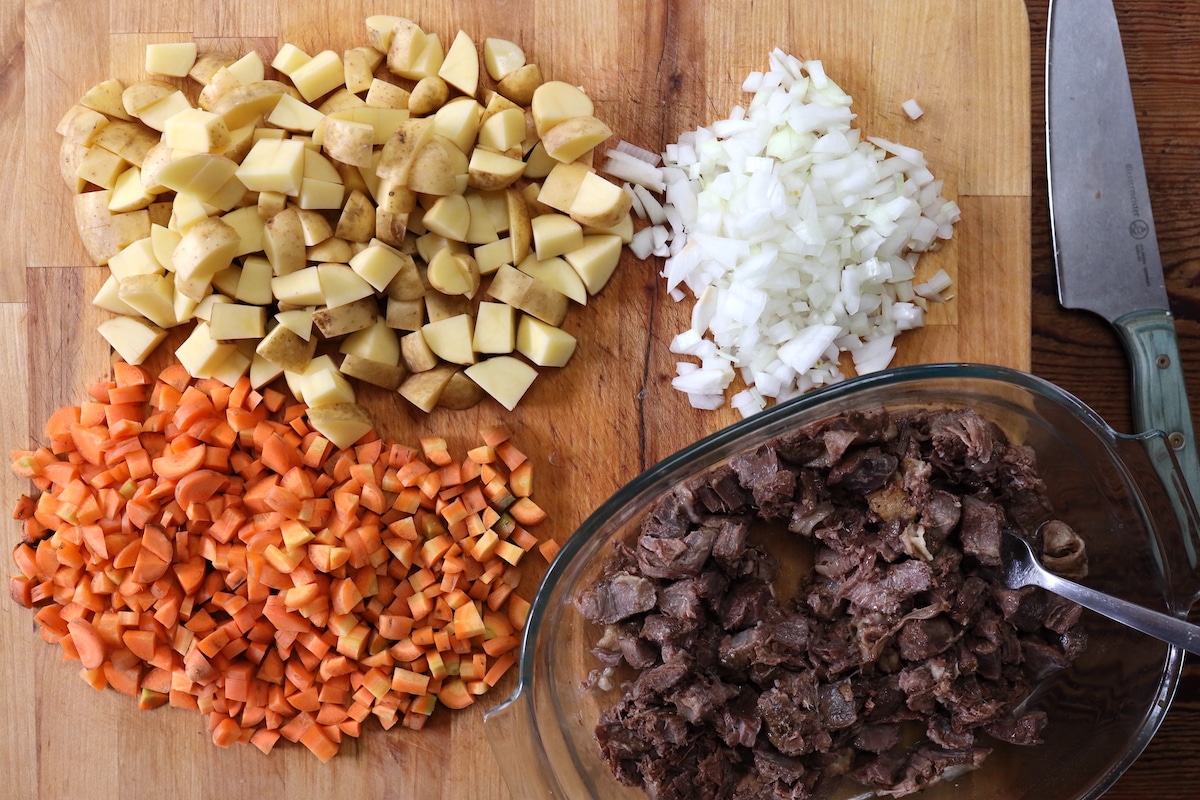
Directions:
1. Heat pan over medium to high heat and sauté garlic and onion in olive oil or other fat until fragrant.
2. Then, add beef soup bones to pan and sear on both sides.
3. Place soup bones, onion, and garlic in slow cooker and cover with water and 1 tbsp of apple cider vinegar.
4. Add the rest of the ingredients to slow cooker besides the tapioca starch or other thickener.
5. Slow cook for 8 hours on low or 200°F (93°C).
6. After cooked, remove bay leaves and bones from the stew.
7. Dissolve tapioca starch or other thickener in water and stir into hot stew pot.
Serve and Enjoy!

Other Beef Soup Bones Recipes
Like I mentioned above, popular recipes using this cut of beef are osso buco and pho. These are other great alternative recipes to put those tender beef soup bones to use.
While including more uncommon cuts of beef can be intimidating, we highly recommend giving it a try!
Here are a few more of the ways we include nose to tail cooking and organ meats in our kitchen:
Pin it for later!
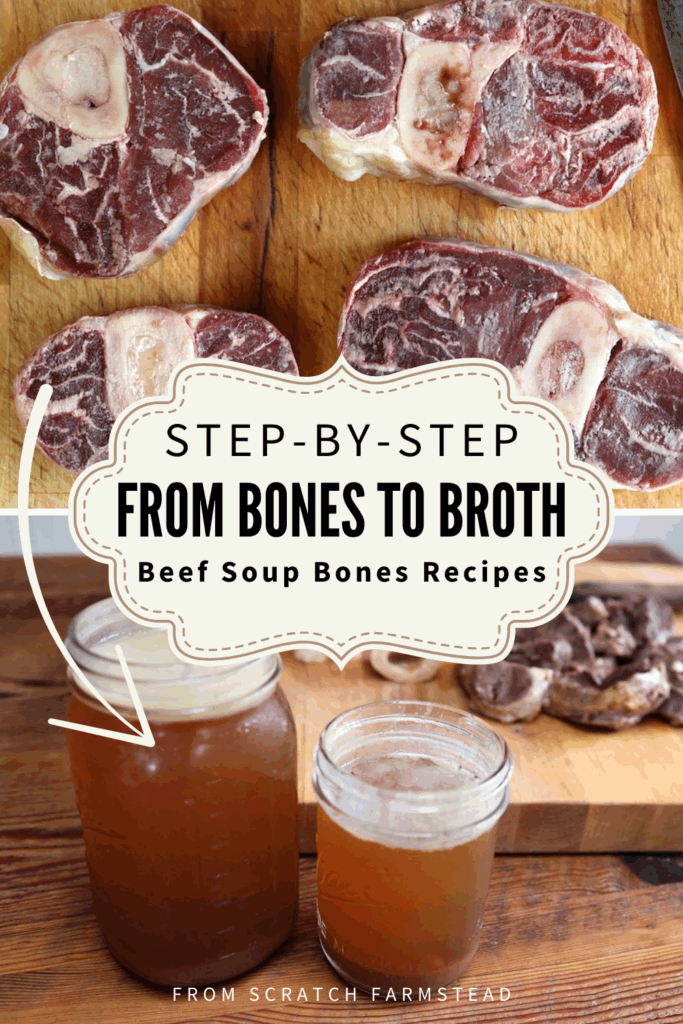
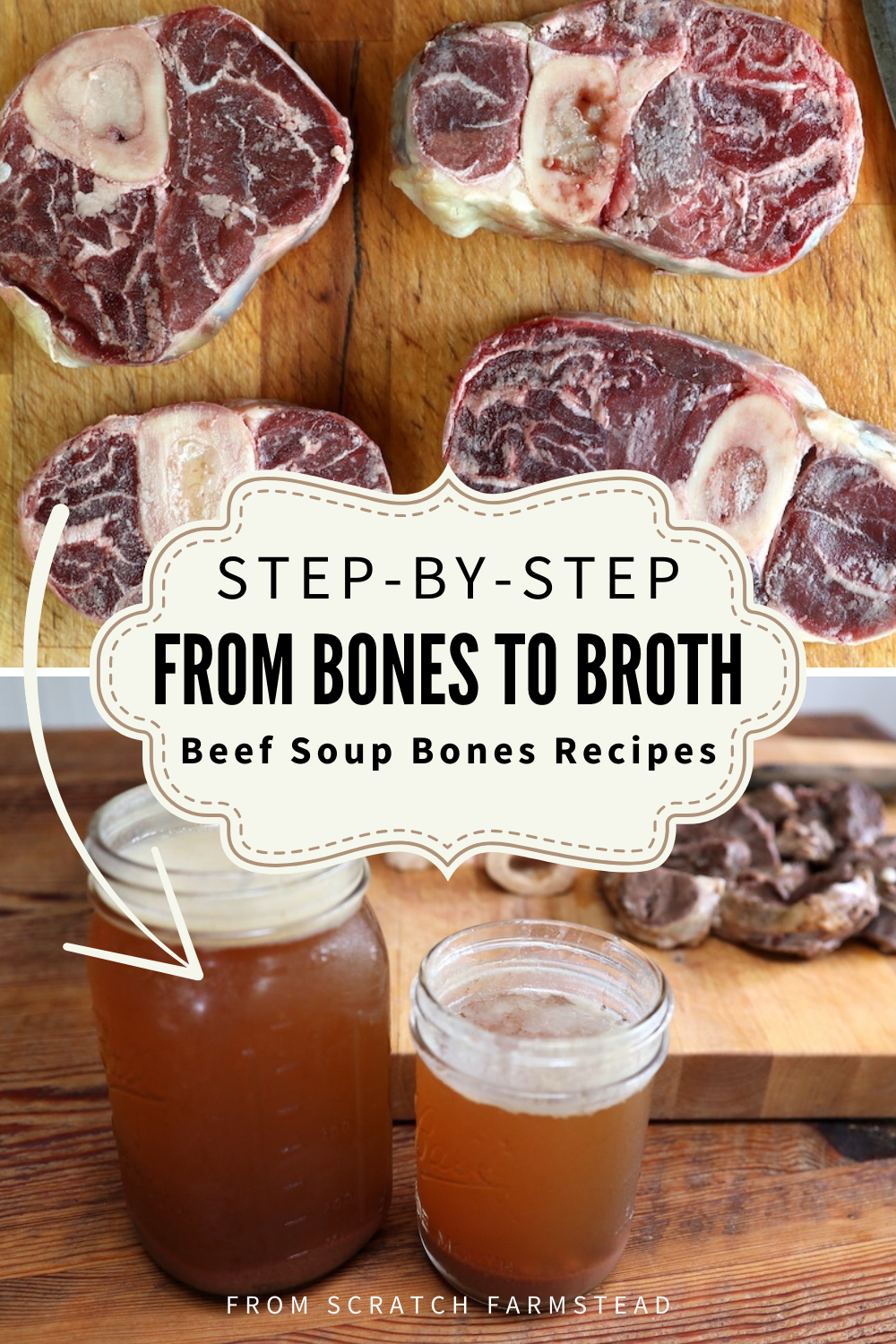
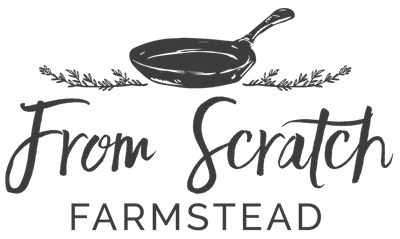
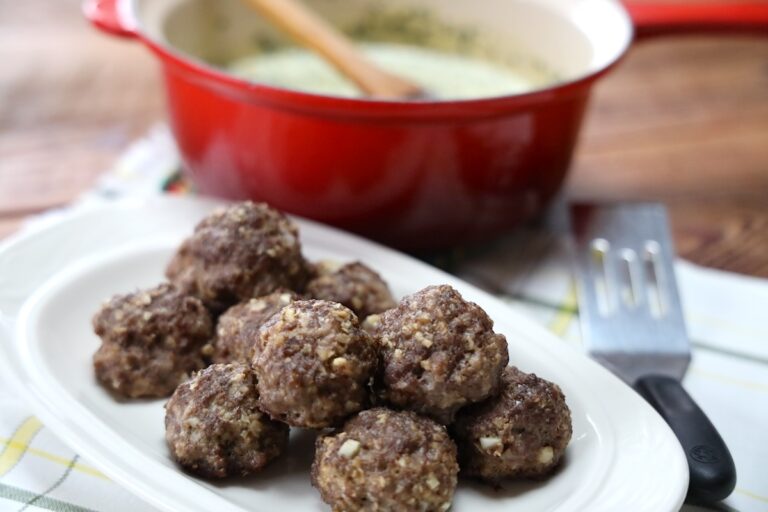
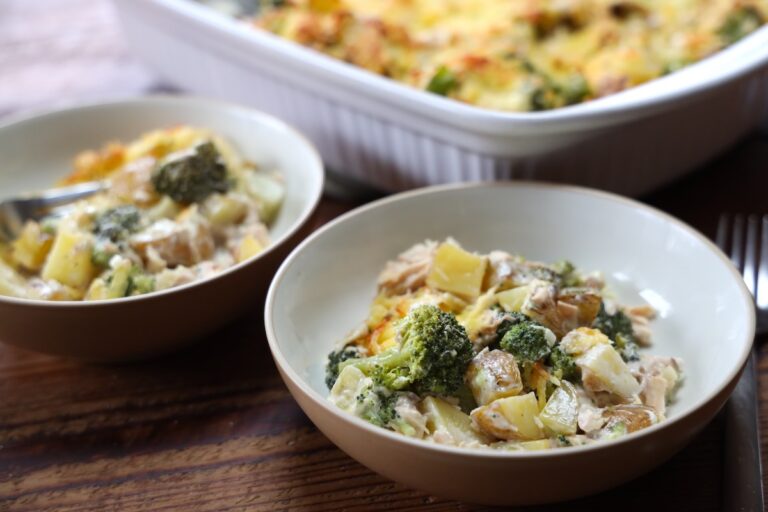
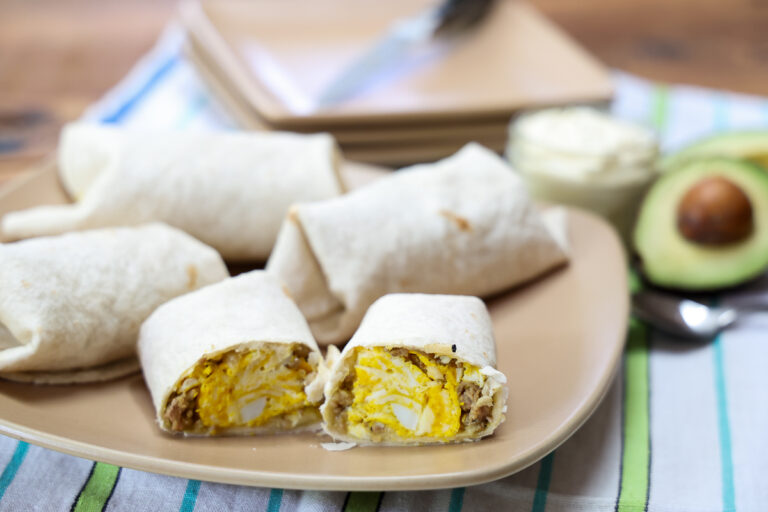

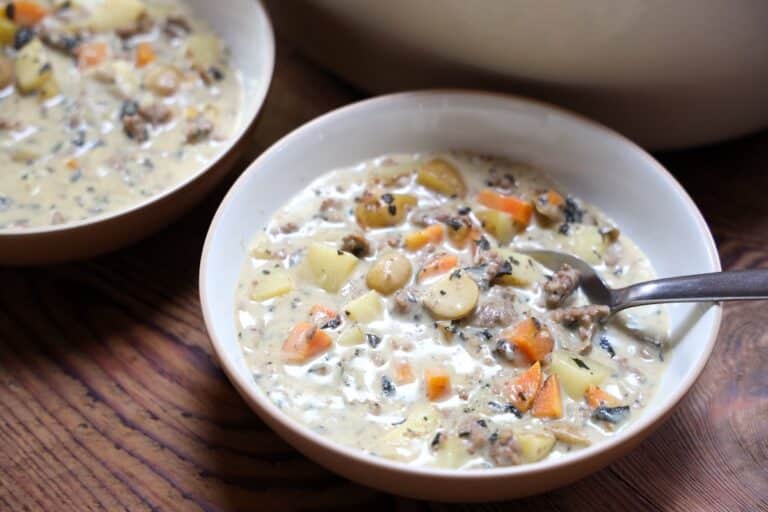

I watched a series one time about professional chefs and how they became the cooks they did based on their personal upbringings. In one specific episode an aging Italian man was a world renowned chef; but he grew up the son of a butcher and they were so poor all he had ever tasted as a child were the poor cuts of beef his father could afford to bring home. When he got a bit older in his life he got to taste his first steak in his life and what did he say? He hated it. He thought it was the most bland piece of meat he had ever tasted. He learned to use all the “poor choice meat” of a cow so well that he embraced it and became famous and very successful in the culinary world only serving sweet meats…….?!!! Love it!
Thank you for sharing your knowledge, your site has been very helpful.
That is so interesting!! Thanks for sharing and honestly, I agree. The slow-cooked cuts of meat are my favorite too!
Have you ever canned the broth?
Yes! You could pressure can the broth.
Thank you for this article and recipes! We live in Northern Maine where a local young couple we know raise cattle and sell the beef in the area. It is wonderful! Our order included several large soup bones. It had been years and years since I’d even seen one. Today my town boys will be tasting the best beef soup ever!
Love that!! I hope you all enjoyed it!
I am making this tomorrow, so excited! If I make the vegetable stew in a dutch oven instead of slow cooker, do I leave it on low on the stove or cook in the oven at 200 degrees for the 8 hours?
Hi! I’d just simmer it on the stove until the vegetables are soft. A couple of hours would be all you need. Or if you put a lid on it, about 20-30 minutes should do it! Hope you enjoy it!
Will it work if you only have the bones and no meat ( or very little meat)?
Will it work if you only have the bones and no meat (or very little meat)?
You can definitely still turn it into broth!
We purchased a half cow from local farm. They had a local company do the processing for them. On the cut sheet, some of the choices were to not take the bones or organ meats. I figure I paid for them, I want them. So, it has been a learning experience on how to cook parts of a cow I’ve never had. The organ meat was the worst. I couldn’t even eat the liver. Fortunately, my dog isn’t as picky as I am, so it didn’t go to waste. Never made bone broth before. Wasn’t difficult an the results were amazing. My final product was like jello. Makes an excellent base for beef stew instead of water or store bought beef broth. Only thing that was confusing was the bones I received. Some were labeled Osso Buco and others soup bones. Basically the same thing, right?
Sounds like an adventure! Every butcher labels things their own way. The butcher we use labels beef soup bones but yes, that would be the same as osso bucco or beef shanks! Good luck!
Your website is wonderful! I’ve passed it along to a few people who are interested in Chickens, recipes, homesteading. I looked up bone broth because my hair is thinning due to ?? Thyroid issues, Hashimotos and most likely my diet. I am changing that slowly.
I will follow your recipes for bone broth and I know it will make a difference. Do you think I should also take a biotin supplement, or will this take care of that, too?
Thanks, (Aunt Pam)
Thank you and thanks for passing it along! 🙂 I’m not sure on supplementation but I definitely think adding in bone broth regularly would be helpful!
This was a great find for me! Thanks for sharing a way to use the beef soup bones I bought with our half cow. Turned out as a really delicious stew that was enjoyed by the whole family. I was really worried about the amount of salt it calls for so I added a little less. Turns out it needed it! I think I’m use to adding in broth that has salt in it. Next time I will follow the amount called for;) I did add in green beans towards the end just so it would have a nice green color in there with all the rest. Just seems like a good stew needs green beans too :). Will definitely be making this again!
Awesome! So glad you liked this one! Thanks for sharing!